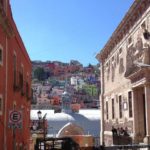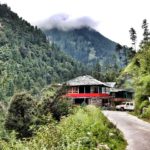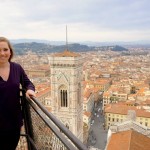Singing in French Churches: How I Joined the Local Choir
Sometimes when you find yourself shivering in the bitter cold in the middle of a cemetery nestled in the misty hills of the French countryside in an unknown village on a Sunday morning, surrounded by people that you don’t know, it’s good to take a step back and ask yourself, “Now how did I get here again?”
The explanation was simple, or rather would have been simple if I were either fluent in French, or learned to stop nodding my head and responding, “Oui, oui,” every time someone spoke to me in this unintelligible, rapid-fire language, and I actually just asked them to slow down and repeat themselves. The problem with not understanding a good amount of the language is that I end up agreeing to things without realizing it and the next thing I know, I’m developing hypothermia in a cemetery.
When I moved to Bar-le-Duc, France in September, I joined a choir. I am the youngest member by at least 15 years, and the only foreigner. While my French skills are frequently lauded in comparison to those of “the previous American,” as she’s disdainfully referred to, I’m still clearly at a disadvantage. It takes a while for me to process information when it’s verbally conveyed, so I was a good week behind everyone else in terms of finding out about an upcoming concert mass. And after that, it came to my attention that it was a mass somewhere not in Bar-le-Duc. Where? I couldn’t tell you because all the surrounding villages are equally incomprehensibly named. How was I to get there? I just hoped that someone would think to offer me a ride. I’d like to think that in some ways I could be compared to a salmon swimming upstream because I usually don’t give into the path of least resistance, but for the past couple of months, I’ve definitely been enjoying thumbing a ride downstream and letting it carry me wherever it ends up going. Which is how I ended up in Sampigny, or Saint Puni, as I thought it was called before I saw it written out as “Saint Punish.”
It was 8:05 am on Sunday morning, and I was waiting in front of the McDonalds, desperately hoping that my ride had forgotten me so I’d have an excuse not to go. An hour earlier, I had woken up, desperately hoping that my minor cold had turned into the flu, or I had lost my voice. No such luck. So as the minutes ticked by in front of McDonalds, I grew more and more excited. At 8:10 am, I thought, if my ride doesn’t show up in five minutes, I’m going home. But of course, that’s when a white Renault pulled up in front of me, with two of my fellow choir members waving from inside. Merde.
On the way to Sampigny, I gazed out the window at the fog-covered countryside, and my stomach clenched as we drove beneath a large, white, spinning windmill, whose vanes sliced threateningly through the air and down towards our little car. The windmills dotted the countryside, their presence disturbing when juxtaposed against the rolling green hills and herds of cows and sheep grazing underneath. Unnatural. When we arrived in the village, I tagged along behind my fellow choristers like an eager but bashful puppy, afraid of being left behind.
The church was cold. A kind of coldness that crept up through your shoes, into your feet, then up your legs and infected the rest of your body. A kind of coldness that buried itself somewhere deep inside of you that you couldn’t shake off. This is why I thought that, in conjunction with my head cold, I might be hallucinating when I looked up from where the choir sat in the nave and saw a woman dressed in a full-out renaissance gown, complete with thick, black ringlets crowning her face. She sat wedged in the front pew, next to modernly dressed people, and it was the discomfort she so clearly exuded that gave her away as a real person and not a figment of my imagination. Renaissance characters from my fantasies always hold themselves with poise.
As I slowly came to realize (once again, a little slow on the uptake), this mass we were singing at was a celebration of the 300th birthday (or was it the anniversary of her death?) of Henriette de Lorraine, a duchess whose castle had been built in Sampigny but destroyed during the First World War. And some poor woman had been given the task of dressing up as Henriette de Lorraine so we could celebrate her in person.
She had obviously been chosen, not for her acting skills, but for her girth, so that she would match the portrait of the real Henriette that now stood propped on an easel next to the pulpit. I found it a little odd that her portrait should be so situated in a place of worship, and that the priest kept comparing Henriette’s kingdom to the day’s Gospel reading and its famous line, “Remember me when you come into Your Kingdom.” Then again, maybe I misunderstood, because I was also sure that the priest said, “Bling-bling.” I was jerked out of my reverie by these words, only to hear him follow up with, “As the young people say today.” So did he really just say that? We’ll never know…
The next thing I knew, I was standing in a cemetery. After mass was over, everyone had gotten in their cars and in funeral procession fashion, we had driven slowly out of town and made our way up, up, up a narrow little road until we found ourselves outside a cemetery flanked on one side by pure nature as far as the eye could see, and, on the other, an ancient farmhouse with smoke pouring doggedly out of the chimney as if to prove it was still inhabited, despite its ramshackled appearance. Everyone pushed their way through the cemetery’s gates and crowded around a shiny new plaque that the wind had prematurely unveiled. I pushed to get a look but was shut-out by others more eager than me. I never did get to read what it said. When the priest and Henriette incarnate arrived, they futilely recovered the plaque with the maroon cloth that lay on the ground, and then re-unveiled it officially.
Meanwhile, I was standing behind the crowds of people pushing to get a view, staring out at the surrounding hills, which were veiled in fog and a mist that stung my eyes with its bitter bite. The view was majestic and I mentally kicked myself for not bringing my camera. But how was I supposed to know where I would end up that day? Perhaps some day I’ll make it back to Sampigny, Saint Puni. I’ll visit the castle ruins and the old mansion of the former French president Poincaré who once made his home here. I’ll revisit the history of this tiny town, once so important– the seat of the duchy, the home of the president– but then boarded up against the biting cold, as the windmills turned and turned and the chimneys spewed out an ancient-smelling smoke.








